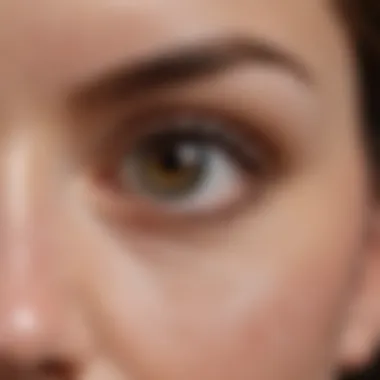When to Apply Differin Gel: Timing & Techniques


Intro
Differin Gel, a topical retinoid, is widely recognized for its efficacy in treating acne. Its primary active ingredient, adapalene, is essential for normalizing skin cell turnover and reducing the formation of acne lesions. For those seeking to harness the full benefits of Differin, understanding the optimal times for application becomes crucial. This guide aims to clarify when and how to use Differin Gel effectively, while providing insights into accompanying considerations such as skin type, common side effects, and alternative treatments.
Research Context
Background Information
The increasing prevalence of acne among adolescents and adults has led to a heightened focus on effective treatments. Topical retinoids like Differin represent a critical component in managing this common skin condition. Unlike many other treatments, Differin operates at a cellular level, promoting effective exfoliation of the skin. Research has demonstrated its ability not just to treat existing acne but also to prevent future breakouts.
Importance of the Study
With the rising availability of various acne treatments, individuals must discern which product aligns best with their needs and lifestyle. This guide targets those who wish to optimize their skin health by maximizing the results from Differin Gel. Understanding application timing, skin type interrelation, and possible side effects informs users about best practices and promotes a safe, effective skincare journey.
Prelims to Differin Gel
Understanding Differin Gel is crucial when it comes to effective acne management. This topical retinoid has gained recognition in skincare due to its ability to prevent acne and improve skin texture. Knowledge about Differin Gel helps individuals make informed decisions about their acne treatment.
What is Differin Gel?
Differin Gel contains the active ingredient adapalene, a third-generation retinoid. It is primarily used for treating acne. Unlike other retinoids, adapalene is less irritating to the skin. This is particularly important for those who experience sensitivities with other acne treatments. Differin works by promoting skin cell turnover, which helps prevent clogged pores—a key factor in acne formation.
Mechanism of Action
The mechanism through which Differin Gel operates involves several processes. It modifies the skin's keratinization process. This means that it helps cells shed more effectively, preventing blockages that lead to acne. Moreover, adapalene has anti-inflammatory properties, which can reduce redness and swelling associated with acne lesions. By interacting with specific receptors in the skin, Differin modulates cellular differentiation, thereby enhancing skin health overall.
Indications for Use
Differin Gel is indicated for the treatment of mild to moderate acne. It is suitable for adolescents and adults alike. It can be used as a standalone treatment or in conjunction with other therapies. However, individuals should not use Differin on areas of broken skin or dermatitis. One must apply it carefully and consistently for optimal results. Regular use can lead to clearer skin and a significant reduction in acne lesions.
Important: Consult a healthcare provider before starting any new treatment to ensure it is appropriate for your skin type.
Optimal Application Timing
Understanding the optimal application timing for Differin Gel is essential for achieving its full benefits. Differin Gel, or adapalene, is a topical retinoid often prescribed to treat acne. The results depend not only on the frequency of application but also on the specific time of day one chooses to apply it. Proper timing can help the skin better absorb the medication and minimize potential side effects.
Applying Differin Gel at the right moment can enhance its effectiveness. This is because the skin can be more receptive to treatment when it is clean and free from other products. Additionally, times of lower activity, such as in the evenings or before bedtime, may provide the skin ample time to absorb the product without interference.
Furthermore, there are variations in skin types that can affect how well Differin Gel works based on the time of application. Oily skin might benefit from application during the day when sebum production peaks. In contrast, people with sensitive skin may find nighttime use optimal to allow for recovery without external irritants that commonly occur during the day.
Best Time of Day to Apply
The best time to apply Differin Gel is generally in the evening, just before bed. Applying at this time allows for continuous absorption while sleeping, reducing the likelihood of exposure to sunlight and other environmental factors that may irritate the skin. Nighttime application can lead to a more effective treatment response.
When applying in the evening, ensure that the skin is cleansed thoroughly and dried completely before application. Using the gel in the evening integrates well into many individuals' skincare routines and encourages a habitual approach.
In some cases, individuals may find applying Differin Gel in the morning more suitable. For instance, this strategy is sometimes adopted by those who wish to align their routines with daytime activities, though care should be taken to apply a sunscreen afterward, as retinoids can increase sensitivity to UV rays.
Frequency of Application
The frequency of applying Differin Gel is crucial for achieving desired results. Initially, most dermatologists recommend using the gel once daily. Consistency is key to allowing the skin to adapt and minimizing potential irritation.


For those new to retinoid treatments, starting with every other night application may be beneficial. This helps the skin acclimate to the medication, as it can cause dryness or irritation during the initial weeks of treatment.
After a few weeks, if the skin seems to tolerate the treatment well, individuals may transition to nightly use. It’s essential to monitor the skin’s response and adjust the frequency accordingly. Some may even choose to use the gel on alternate nights or a few times a week based on their skin’s specific needs and any recommendations from their healthcare provider.
Consideration of Skin Types
Understanding your skin type is crucial when using Differin Gel, as it influences the efficacy and potential side effects of the treatment. Different skin types react uniquely to topical medications. Applicating Differin Gel without considering your skin characteristics may lead to unexpected results. Hence, personalized application strategies can maximize benefits and minimize adverse effects. Knowing whether you have oily, dry, or sensitive skin can guide the integration of Differin into your skincare routine effectively.
Oily Skin
For individuals with oily skin, Differin Gel can be particularly advantageous. Oily skin is characterized by excess sebum production, which can lead to acne and blemishes. This skin type often benefits from the exfoliating properties of Differin, as it helps in unclogging pores and preventing acne. When using Differin, it is advisable to apply it to clean, dry skin at night.
Over-application can lead to irritation, so a pea-sized amount is typically sufficient. If excessive oiliness is still an issue, consider incorporating gel-based moisturizers, which do not add excessive weight to the skin.
Dry Skin
Dry skin presents a different set of challenges. The use of Differin Gel can sometimes exacerbate dryness and cause peeling. Therefore, those with dry skin should consider a careful approach. It is essential to hydrate the skin adequately before applying Differin. Users should wash their face with a mild cleanser and apply a moisturizer designed for dryness.
After allowing the moisturizer to absorb, the gel can be applied. A smaller amount of Differin—perhaps less than the typical pea-sized recommendation—may be advised at first. Gradually increasing the frequency of application can help skin adjust while minimizing irritation.
Sensitive Skin
Sensitive skin requires careful handling with any topical treatment. Since Differin can sometimes lead to redness and irritation, individuals with sensitive skin must consider their options. Patch testing is recommended before widespread application. For those who find that their skin reacts negatively, it may be wise to alternate application days or reduce the quantity applied.
Incorporating soothing products, such as aloe vera gel or calming moisturizers, may help alleviate irritation. Furthermore, applying Differin after a moisturizing step could create a barrier that protects the skin from potential adverse effects.
"Adjusting application based on skin type can transform Differin Gel into an effective ally in skincare, rather than a potential irritant."
By understanding the nuances of your skin type, selecting the right approach to use Differin Gel becomes a more deliberate process, paving the way for more effective acne management.
Incorporating Differin into Your Skincare Routine
Incorporating Differin gel into your skincare routine is key to maximizing its benefits while minimizing potential side effects. This step is crucial as it allows the skin to adapt to the medication. Differin, primarily used to treat acne, helps in reducing the formation of clogged pores. However, how one integrates it plays a significant role in its effectiveness.
Applying Differin does not mean eliminating other skincare products. Rather, it should complement a well-thought-out skincare regimen. This section will explore essential aspects of incorporating Differin, including pre-application cleansing, product layering, and post-application moisturization.
Cleansing Before Application
Cleansing is one of the foundational steps in any skincare routine, especially before applying Differin. Before using the gel, wash your face gently with a mild cleanser. This removes dirt, excess oil, and other impurities that can interfere with the absorption of the product.
A clean surface allows Differin to penetrate more effectively. It also reduces the risk of irritation that may arise when dirt or makeup remains on the skin. When selecting a cleanser, it is important to choose one that is appropriate for your skin type, whether oily, dry, or sensitive. Avoid cleansers that contain harsh ingredients, as these can exacerbate dryness or irritation.
Layering Products
The order in which products are applied is significant. Differin should be applied after cleansing but before heavier products like moisturizers or oils. When layering products, allow each layer to absorb fully before applying the next. This ensures that Differin does not get diluted or blocked by other products.
It’s also useful to consider the types of ingredients in other products being used. Certain active ingredients, such as AHAs or BHAs, can increase skin sensitivity when used with Differin. Therefore, it’s advisable to limit the use of such ingredients, especially during the initial weeks of using Differin. This approach helps maintain skin health while maximizing the benefits of retinoid treatment.
Moisturization Post-Application
Moisturizing after applying Differin is essential. Differin can cause dryness and irritation, especially during the first few weeks of use. A good moisturizer helps to counteract these effects and keeps skin hydrated. Choose a non-comedogenic moisturizer that will not clog pores.


Applying moisturizer after Differin can create a barrier that protects the skin and provides additional hydration. Ideally, one should apply the moisturizer after waiting 20 to 30 minutes post-Differin application. This ensures that the gel has ample time to absorb into the skin, allowing for better results.
In summary, incorporating Differin into your skincare routine requires attentive steps to enhance its efficacy. Cleansing properly sets the stage for better absorption, while careful layering of products ensures that other active ingredients do not hinder its effectiveness. Finally, adequate moisturization is vital for maintaining skin balance and tackling any potential irritation.
Managing Side Effects
Understanding and managing side effects is crucial when using Differin Gel as part of acne treatment. Improper handling of these effects can lead to poor adherence to the treatment regimen, reducing the effectiveness of the product. Knowing what to expect enables individuals to navigate through discomfort or irritation while maintaining the benefits of the medication. Proper education about side effects fosters better outcomes and helps in preserving skin health.
Common Side Effects
When using Differin Gel, some common side effects may occur. Patients should be aware of these to set proper expectations. These include:
- Redness: Often occurs in the first few weeks of application.
- Dryness: Skin may feel tight or flaky.
- Peeling: A natural response as the skin adjusts to the treatment.
- Burning or stinging: Mild sensations can be common, especially after initial applications.
- Sensitivity to sunlight: Increased risk of sunburn is a recognized side effect.
Recognizing these side effects is important. They indicate that the product is working but can discourage continued use if not managed correctly.
"Understanding the common side effects can greatly improve the user experience and the long-term success of Differin Gel."
How to Mitigate Side Effects
Mitigating side effects is essential for ensuring a smoother experience with Differin Gel. Here are some effective strategies:
- Gradual Introduction: Begin by applying Differin Gel every other night instead of daily. This allows the skin to adapt slowly.
- Moisturizing Regularly: Use a non-comedogenic moisturizer after applying Differin to counteract dryness and provide a barrier.
- Sunscreen Application: Daily use of a broad-spectrum sunscreen significantly reduces the risk of sunburn.
- Avoid Harsh Products: Refrain from using other potentially irritating skincare products, such as those with alcohol or strong exfoliants.
- Consultation with a Dermatologist: If side effects become unmanageable or severe, it is prudent to seek professional advice. A healthcare provider can offer tailored solutions and possibly adjust the treatment plan.
Managing side effects is integral to maximizing the benefits of Differin Gel while minimizing discomfort.
Evaluating Effectiveness Over Time
Evaluating how well Differin Gel works over time is crucial for users seeking optimal acne treatment. Understanding this phase is not just about tracking visible improvements; it often affects compliance and expectations. As such, being aware of what to expect can influence how users manage their treatment regimen and psychological wellness.
Timeline for Results
Users of Differin Gel often wonder when they will start to see results. Generally, the timeline can vary based on several factors, including skin type, severity of acne, and adherence to the application regimen. Here’s what a typical timeline might look like:
- Week 1-2: Initial breakout or irritation may occur as the skin adjusts to retinoid. This can be disheartening but is often a normal response.
- Week 3-4: Some mild improvement may be noticed. The skin starts to become less congested, and acne lesions may begin to reduce.
- Month 2-3: More significant improvements usually become apparent. Users often report fewer breakouts and improved skin texture.
- Beyond 3 months: Continued use can lead to gradual but steady improvement, potentially leading to noticeable clearer skin.
The key is patience. Differin Gel is not an overnight solution; understanding this timeline helps set realistic expectations.
Signs of Improvement
Recognizing the signs of improvement is a vital part of evaluating Differin Gel's effectiveness. Here are some indicators that users might observe:
- Reduction in Breakouts: A noticeable decline in the frequency of new acne lesions can be one of the first signs.
- Smoother Skin Texture: Users may feel that their skin's texture is becoming more even and less bumpy.
- Faded Acne Scars: With consistent use, post-inflammatory hyperpigmentation can also start to fade.
- Enhanced Overall Skin Appearance: Skin may appear brighter and healthier as impurities are eliminated over time.
It's essential to track these improvements carefully. Keeping a journal or regular photo documentation of skin condition can assist users in not just noticing changes, but also in reaffirming that their efforts with Differin Gel are worthwhile.
"Patience and consistent application are vital when using Differin Gel for acne treatment."
Alternatives to Differin Gel
Considering alternatives to Differin Gel is crucial for individuals who may not respond well to this treatment or those seeking different options for acne management. While Differin Gel is effective for many, varying skin types and conditions may necessitate exploring other therapies. Understanding these alternatives enables users to make informed choices tailored to their skin needs.


Other Topical Treatments
Several topical treatments can serve as alternatives to Differin Gel, each with distinct mechanisms and benefits. Here are some notable ones:
- Benzoyl Peroxide: Known for its antibacterial properties, this ingredient effectively reduces acne breakouts. It can unclog pores and lessen inflammation.
- Salicylic Acid: This beta hydroxy acid exfoliates the skin, helping to clear pores and reduce acne. It might be more suitable for individuals with oily skin types.
- Tretinoin: A stronger retinoid, it offers enhanced effects for severe acne cases. However, it may present more side effects compared to Differin.
- Clindamycin: An antibiotic that targets bacteria causing acne, often used in combination with benzoyl peroxide for increased efficacy.
When choosing a topical treatment, factors such as skin sensitivity, acne severity, and potential side effects should be taken into account. Personalized evaluation and preferences play a significant role in finding the right option.
Oral Medications
In cases where topical treatments prove insufficient or not suitable, oral medications can be considerd as an alternative route for addressing acne. These include:
- Antibiotics: Medications like doxycycline or minocycline target bacterial overgrowth and treat inflammatory acne. They are usually prescribed for moderate to severe cases.
- Hormonal Therapy: For some women, hormonal imbalances contribute to acne. Birth control pills can help regulate hormones and improve skin.
- Isotretinoin: This medication is reserved for severe, persistent acne that does not respond to other treatments. While it is highly effective, it carries significant side effects and requires close monitoring during treatment.
Before opting for oral medications, consulting with a healthcare professional is vital. Medical advice ensures that the choice fits individual needs and minimizes potential risks.
Consulting a Healthcare Professional
Consulting a healthcare professional is a crucial aspect when it comes to using Differin Gel effectively. This step ensures that users receive tailored advice based on their unique skin conditions and concerns. Many individuals may feel tempted to start treatment without professional guidance, yet this can lead to suboptimal results or adverse effects.
A healthcare professional can provide insights that consider the patient’s medical history, existing skincare routines, and any other medications they might be taking. Evaluating these factors can help identify potential interactions or contraindications. If any issues arise during treatment, these professionals can modify approaches or suggest alternative therapies.
When to Seek Professional Advice
There are specific situations when consulting a healthcare professional becomes especially important. These include:
- Persistent Acne: If acne does not show improvement after several weeks of use, it is crucial to seek advice. This can indicate that Differin Gel may not be suitable for the individual or that additional treatments are necessary.
- Severe Side Effects: While mild irritation can be common, severe reactions such as peeling, redness, or excessive dryness should prompt consultation.
- Understanding Specific Skin Conditions: For individuals with conditions like eczema or rosacea, using a product like Differin might pose risks. Guidance helps navigate these complexities.
- Questions About Ingredients: If a user has concerns about particular ingredients or a new skincare regimen, professional input offers clarity.
"Always prioritize your skin's health. The right advice can make a substantial difference in your treatment journey."
Individualized Treatment Plans
Creating an individualized treatment plan with a healthcare professional can greatly enhance the efficacy of Differin Gel. Each person’s skin is different, and what works for one may not work for another. An individualized plan can involve the following elements:
- Customized Usage Instructions: A professional may recommend a specific frequency of application or adjustments based on skin tolerance. This approach helps minimize side effects and optimize results.
- Complementary Products: The professional can suggest compatible skincare products that work well together with Differin Gel, ensuring an overall effective skincare routine.
- Monitoring Progress: Regular follow-ups allow for adjustments. Professionals can track improvements and setbacks, making necessary changes to the plan as needed.
- Education: Clear guidance about what to expect can help patients remain informed and engaged in their skincare journey.
End and Recommendations
In the realm of acne treatments, Differin Gel has emerged as a significant player, valued for its potential to address various skin concerns. Concluding this guide emphasizes the importance of understanding when and how to apply Differin Gel. This knowledge can transform a basic skincare routine into a tailored approach that maximizes efficacy while minimizing adverse reactions. Ultimately, an informed application schedule allows individuals to harness the full benefits of Differin Gel.
Differin Gel operates best when applied consistently and with attention to skin type. Recognizing these specific needs is imperative for success. Furthermore, the considerations surrounding potential side effects underscore the need for prudent use. By understanding these factors, individuals can reduce discomfort and other complications often encountered during treatment.
In summary, this guide outlines crucial information that offers clear pathways to effective use. As the journey to clearer skin unfolds, recommendations based on individual skin types, management strategies for side effects, and ongoing evaluations of treatment progress are paramount. Each of these elements plays a role in fostering optimal results.
Summary of Key Points
- Differin Gel is best applied at night, allowing it to work effectively while the skin undergoes its natural repair process during sleep.
- Skin type significantly influences application frequency and intensity of the product. Oily, dry, and sensitive skin types may require different approaches.
- Common side effects can include irritation and dryness but can often be mitigated with proper moisturizing strategies and gradual introduction into the skincare routine.
- Monitoring skin for signs of improvement is critical. After the initial application phase, it is important to assess whether the gel is working efficiently, with noticeable changes in acne severity.
Final Thoughts on Differin Gel
In closing, Differin Gel represents a scientifically-backed option for acne management, requiring careful attention and commitment. Its retinoid properties can provide significant benefits for those struggling with acne or related skin issues. Users must approach this treatment with an awareness of their unique skin characteristics and potential challenges.
This journey may present frustrations, but with a clear understanding and appropriate application, the path to healthier skin can be achievable. By integrating knowledge and adapting routines, individuals can experience the transformative effects Differin Gel offers.
"Understanding your skin’s needs, and aligning them with your treatment, is an essential step towards success."
For deeper insights into skincare at large, articles from reputable sources such as Wikipedia, Britannica, and engaging discussions on platforms like Reddit can provide additional context and support as one navigates their skincare journey.















